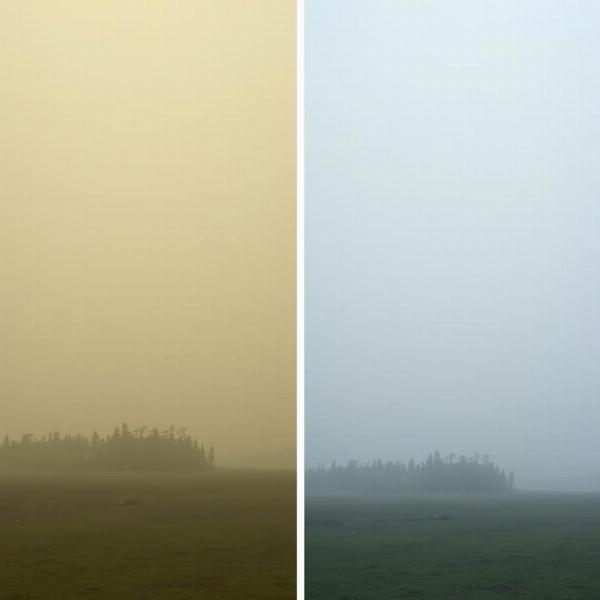Haze weather, a common occurrence in many parts of India, often leaves people searching for its meaning in Hindi. Understanding the nuances of haze, its causes, and its impact is crucial, especially in a linguistically rich country like India. This article delves into the various Hindi terms used to describe haze, exploring their subtle differences and cultural context. We will also discuss the implications of haze on daily life and the environment.
Decoding “Haze” in Hindi
The most common Hindi word for haze is dhundh. However, it’s not a perfect translation. Dhundh primarily refers to a thicker, more opaque fog, often associated with colder weather. While it can sometimes be used for haze, more precise terms exist. For instance, kuchh dhumil translates to “slightly smoky,” reflecting the visual effect of haze. Another term, kasumbhi, describes the yellowish tint often observed in hazy skies. Finally, afaq ki dhool, literally “dust of the horizon,” poetically captures the distant, blurry quality of haze. The choice of word depends on the specific characteristics of the haze and the regional dialect.
Causes and Effects of Haze in India
Haze in India often results from a combination of factors, including vehicular emissions, industrial pollution, and agricultural practices like stubble burning. These activities release tiny particles into the atmosphere, creating a veil that reduces visibility and impacts air quality. The effects of haze can range from mild irritation of the eyes and throat to more serious respiratory problems, particularly affecting vulnerable populations like children and the elderly.
Impact on Daily Life
Haze disrupts daily routines in various ways. It can lead to flight delays and cancellations, traffic congestion due to reduced visibility, and health advisories urging people to limit outdoor activities. Imagine planning a picnic only to be met with a hazy sky, forcing a change of plans. These disruptions underscore the importance of understanding and addressing the causes of haze.
Understanding the Difference between Haze, Fog, and Mist
Many often confuse haze with fog or mist. While all three reduce visibility, they differ in their formation and appearance. Fog is a dense cloud of water droplets near the ground, creating a thick, white blanket. Mist, on the other hand, is lighter and less dense than fog. hindi meaning of mist provides a detailed explanation. Haze, unlike fog and mist, is primarily caused by dry particles suspended in the air, resulting in a greyish or yellowish tint. dhund meaning in hindi provides further clarity on the distinctions.
What causes haze specifically?
Haze is specifically caused by dry particulate matter, such as dust, smoke, and industrial pollutants, suspended in the air. This differs from fog and mist, which are formed by water droplets.
 Comparing Haze and Fog
Comparing Haze and Fog
Combating Haze: A Collective Effort
Addressing the issue of haze requires a multi-pronged approach. Implementing stricter emission standards for vehicles and industries, promoting sustainable agricultural practices, and raising public awareness about the impact of pollution are crucial steps. Individual actions, such as using public transportation, reducing energy consumption, and avoiding open burning, can also contribute to cleaner air.
Conclusion
Understanding “haze weather meaning in hindi” involves more than just a simple translation. It requires exploring the various terms used, recognizing the nuances of their meaning, and appreciating the cultural context. By understanding the causes and consequences of haze, we can work towards mitigating its impact on our health and environment.
FAQ
- What is the exact Hindi word for haze? There isn’t one exact word. Dhundh, kuchh dhumil, kasumbhi, and afaq ki dhool are all used depending on the specific characteristics of the haze.
- Is haze dangerous? Prolonged exposure to haze can lead to respiratory problems, especially for vulnerable groups.
- How is haze different from fog? Fog is made of water droplets, while haze consists of dry particles like dust and smoke.
- What can I do to reduce haze? Using public transport, reducing energy consumption, and avoiding open burning are helpful.
- Where can I find more information about air quality in India? You can refer to the Central Pollution Control Board website for real-time air quality data.
- What is the meaning of ‘kohara’ in Hindi? Kohara is another word for fog, often used in North India. You can learn more about it in our article kohara meaning in hindi.
- Where can I find more information about the different types of fog and mist in Hindi? Check out our comprehensive article meaning of fog in hindi.
Meaning-Hindi.in is your one-stop solution for all your Hindi translation needs. We offer a wide range of translation services, including business and commercial document translation, certified and legal document translation, technical and user manual translation, website and localization translation, educational and academic document translation, express translation, and specialized translation. Our expert team ensures accurate and culturally sensitive translations. Contact us today for a free quote at [email protected] or call us at +91 11-4502-7584. Meaning-Hindi.in understands the nuances of the Hindi language and strives to provide high-quality, professional translation services. haze in hindi meaning is just one of the many topics we cover to bridge the language gap.